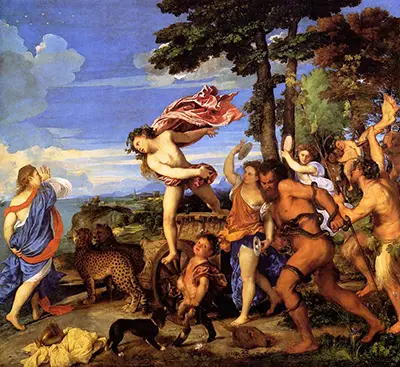Bacchus and Ariadne was painted by Titian between 1520 and 1523.
It was commissioned by Alfonso d’Esta, Duke of Ferrara. The Duke wanted to create a gallery of mythological artwork by the greatest artists of his time for his private room.
It forms part of a collection, other works include The Feast of the Gods by Giovanni Bellini, Titian's teacher and inspiration, The Bacchanal of the Andrians and The Worship of Venus both by Titian. Bacchus and Ariadne was originally commissioned to Raphael but he had only made a preliminary sketch before his death so Titian took over the commission.
The piece is an oil on canvas and has been restored several times. After the dissolution of the collection from the d'Esta family, the painting was twice stored rolled up in the seventeenth century which had heavy consequences for the painting. In the nineteenth century the paintings flaking paint needed restoring. Most controversially in 1967 the National Gallery in London removed a discoloured varnish layer from the surface which also removed some paint. An extensive repaint was necessary, most notably the bright blue areas of sky. Critics argue that the painting has lost much of its original lustre in this restoration.
In this painting Titian masterfully illustrates a narrative story through one frozen moment in time. Ariadne is the daughter of King Minos of Crete. She helped the Athenian hero Theseus kill the Cretan Minotaur and escape his labyrinth and left Crete with him. As she is sleeping on the Island of Naxos Theseus abandons her and sails away. His ship is seen heading toward the horizon over her shoulder. Ariadne is surprised by Bacchus, god of wine, and his noisy followers who are on their way back from India. This is beautifully rendered in her body position.
She is reaching for her departed lover with one arm but as she turns toward the unexpected sound she locks eyes with Bacchus. It is movingly the very epitome of love at first sight. He throws himself from his chariot to meet her. He is carefree and concerned only about reaching her. He looks as though he has given no thought to how he will land, such is his anxiety to reach her. According to Ovid and Catullus, whose mythological poems are the basis for this painting, Bacchus offers Ariadne the sky as a wedding gift. He is a god but she is mortal and eventually she will be immortalised as the constellation of Corona Borealis which Titian paints above her head.
Bacchus is recognised by his classical associations. He has grape and laurel leaves in his hair and he is in the company of his satyrs who are linked with drunken revelry. Bacchus is connected with big cats, he is sometimes described in classical literature as having leopard skin garments. Ovid portrays his chariot as being pulled by tigers or panthers. Titian shows the chariot being pulled by a pair of lifelike cheetahs. This could be a gesture to his patron as the Duke is thought to have owned a menagerie which included a cheetah. Silenus, Bacchus foster father, is present drunkenly asleep on his donkey. The darker side to Bacchus is alluded to by Titian. There is a calf head on the floor and one of the revellers is waving a limb that has been torn from the calf. This demonstrates the uncontrolled passion and debauchery which is attendant to Bacchus’ rituals.
Titian shows a degree of botanical accuracy that is usually a hallmark of his later work. The Iris on the woodland floor and the Capel flowers are delightfully illustrated. The landscape features are well preserved on the painting and they show Titian's technical brilliance as the sunlight ripples across the fields. Titian’s colour choices, bright blues highlighted by oranges and contrasted by softer woodland shades gives the painting such an impression of light that it seems as though the painting is backlit.




